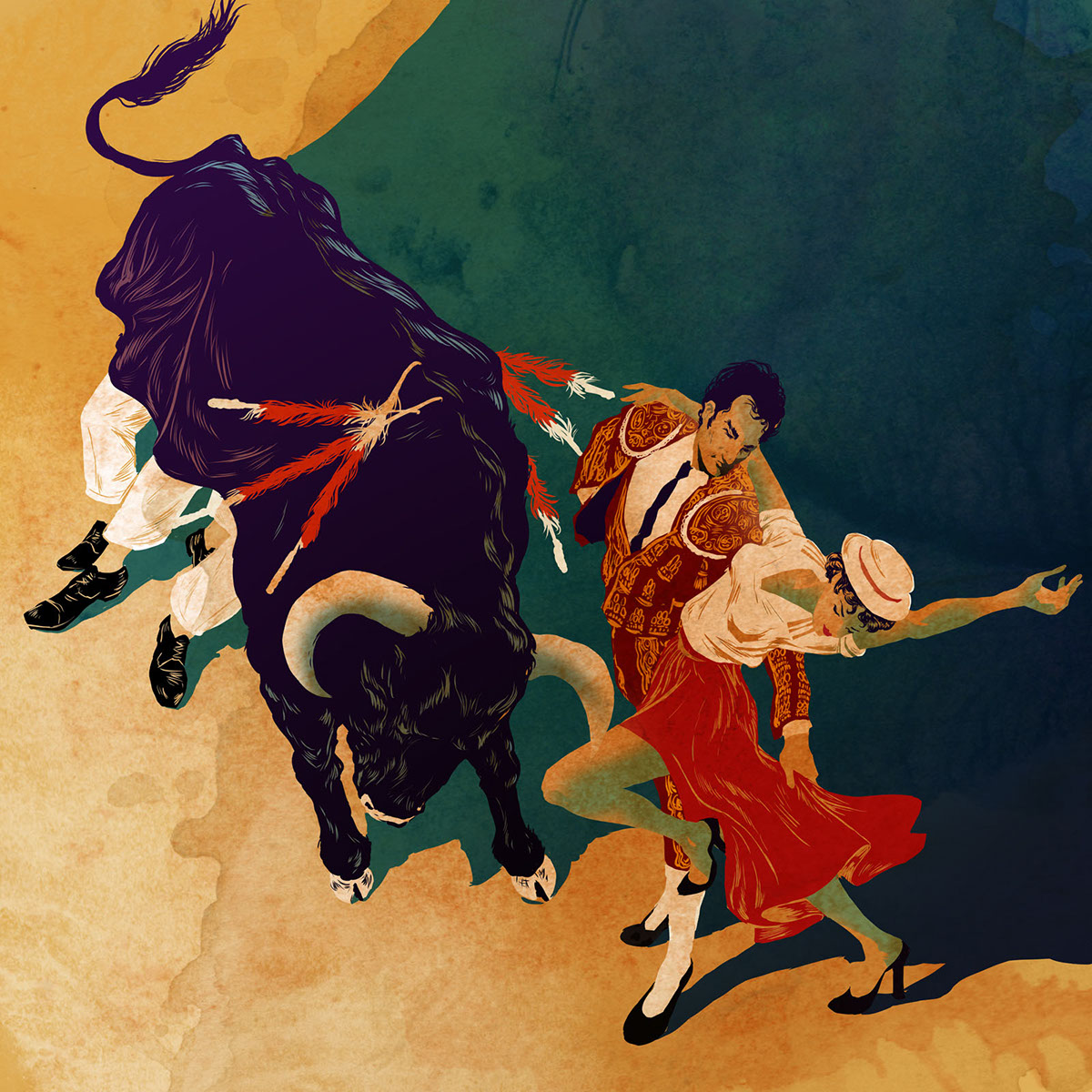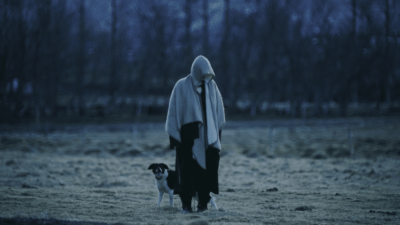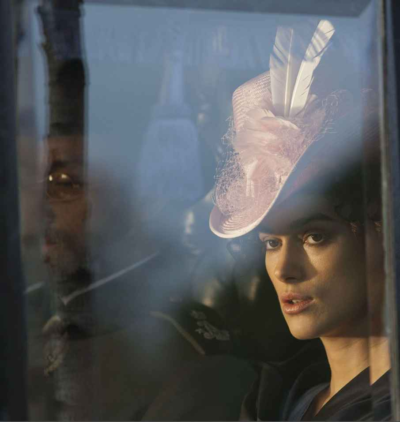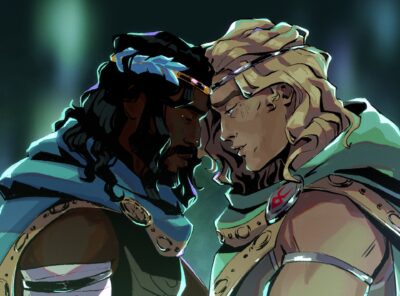My Reading Experience
When I first heard of Ernest Hemingway, I heard that he was a little bit of a posturing tough guy. I do not remember where this was from, unfortunately, because even if it is correct it does not show itself in The Sun Also Rises. I had a preconceived notion that his macho identity mirrored itself in his writing and was why he wrote about boxing, sport fishing, hiking and in this case bullfighting. So, I knew that going into The Sun Also Rises there was Bullfighting and at first figured it was just another example of him writing about his own macho interests. Not the case at all, though. It is clear to me that the interest the main characters feel towards bullfighting, in this specific novel, is a metaphor for the men and their awkward interest in the same girl. In the featured image, you can see a man tango dancing with a woman whilst avoiding a bull with an odd amount of human feet. While I do not want to get ahead of myself, the bullfighting mentioned seems to me as more of a metaphor, one well captured in this image where a man dances out of the way of a group of other men, woman in hand.
The entire novel is about the extended lovers quarrel between roughly half a dozen men, the same woman, Brett, and her ability to toe the line to keep them all interested and even friends with each other. She essentially is sleeping with an entire friend group (friends more or less) of men at the same time, whilst they all stay interested in her and fancy their chances. Here I was, completely unaware that the first ever rendition of The Bachelorette took place in a novel set in 1920’s Europe.
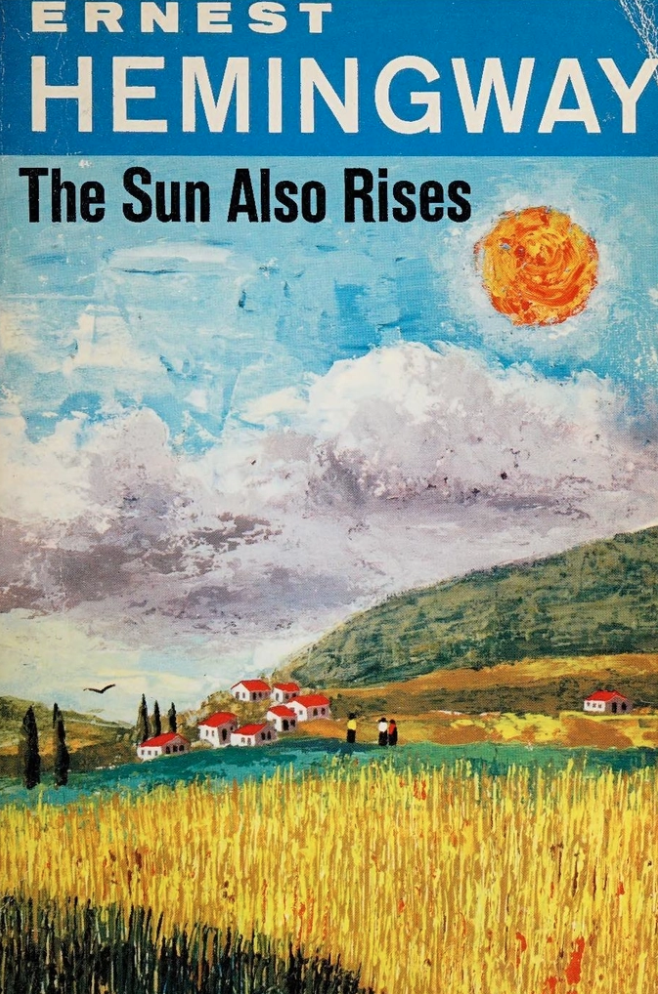
Brett keeps toying with every man’s feelings, denying them peak importance and attention, but keeps them interested enough that they stay around, part of the group of hopeful partners. She then, will regularly and repeatedly cancel on them at the last moment, or more commonly ask one of them to help set her up with someone else or just make it appear she is interested in other men. This act of interest, demonstrated in the painting below, is almost like a matador tricking a bull. A matador will bait its intent then step out of the way at the last moment. Also demonstrated in the painting below is how these crafty, social gymnastics from Brett are usually in front of an audience, metaphorically or literally. Brett baits them with her attention and perceived interest, only to trick them and move out of their grasp at the last moment. Despite this, just like a bull, the men are just engaged enough by the proximity of their goal to stay determined and go after the matador again.
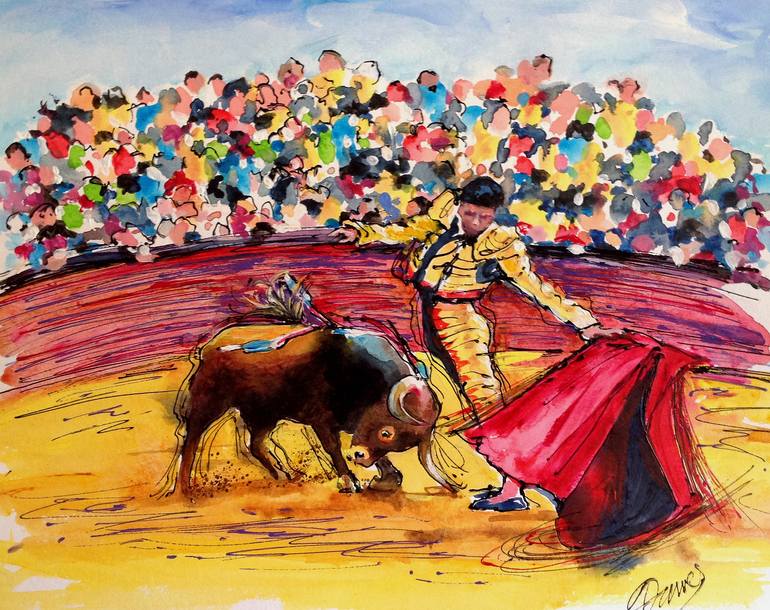
Another overarching theme over this story is one familiar with Hemingway: the post WWI generation, specifically those who fought in the war or were young adults during the war. Solidified by a famous conversation between him and his mentor Gertrude Stein.
“That’s what you all are,” she said to him. “All of you young people who have served in the war. You are a lost generation.”
Hemingway asked why that is.
“You have no respect for anything,” she replied. “You drink yourselves to death.”
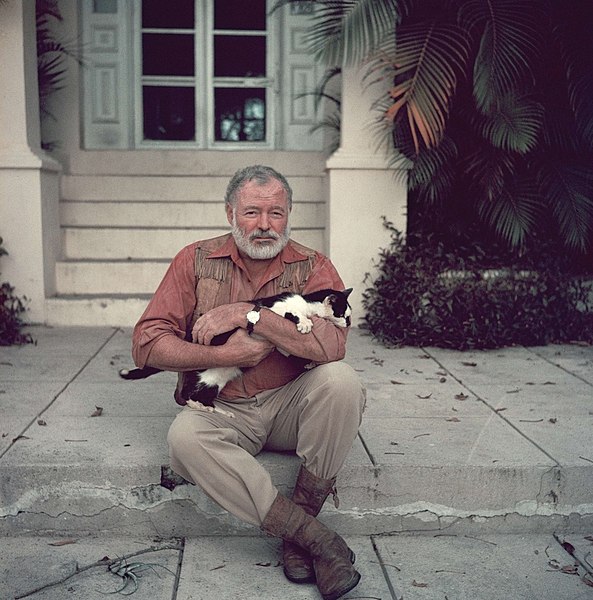
The way Hemingway portrays the lifestyle of these, a lot of them recent WWI veterans, is reflective of how he lived his life in Paris on the writing scene as a veteran, just like Jake. Drinking somewhere between a little too much and dangerous, front facing friendship hiding serious beefs or disinterest and every night spent out on the town. This novel is a story about a generation of people he was apart of and the flaws they all took home from the battlefield with them. Hemingway’s generation and even his friends throughout his life share many similarities to Jake, Brett and there friends. Whether that being the avid drinking problem, lack of purpose or place and a relentless attack towards finding a partner as a representation for companionship not often found.
This also could be perceived as Hemingway’s take on the generational debate, specifically the detest for whatever they youngest generation is by the oldest generation at the time. These individuals were ruled out by their elders at the time, felt lost and were heavily criticized. Just like the baby boomers who were hippies, outcasted and criticized by their elders, who then beefed with millennials, then finally boomers and millennials teaming up for beef with Gen Z. Those are the big fights I am aware of, but it happens to every generation and it does seem as if Hemingway’s story about men aimlessly wandering through life in Europe grasping for purpose and companionship is influenced by the, at the time, criticism from the people they should be learning from.
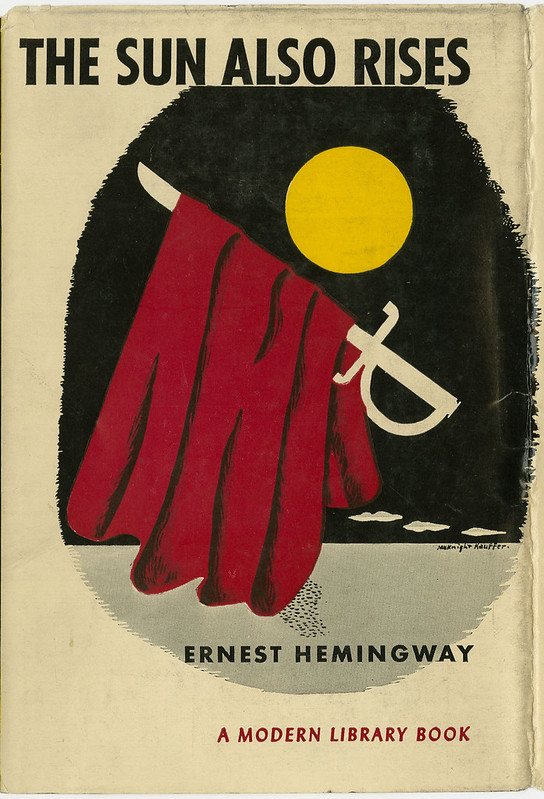
Plot Summary
“On the surface, the novel is a love story between the protagonist Jake Barnes—a man whose war wound has made him unable to have sex—and the promiscuous divorcée Lady Brett Ashley. Jake is an expatriate American journalist living in Paris, while Brett is a twice-divorced Englishwoman with bobbed hair and numerous love affairs, and embodies the new sexual freedom of the 1920s. Brett’s affair with Jake’s Princeton friend Robert Cohn (whom the characters often refer to by his last name) causes Jake to be upset and break off his friendship with Robert; her seduction of the 19-year-old matador Romero causes Jake to lose his good reputation among the Spaniards in Pamplona.
Book One is set in the café society of young American expatriates in Paris. In the opening scenes, Jake plays tennis with Robert, picks up a prostitute (Georgette), and runs into Brett and Count Mippipopolous in a nightclub. Later, Brett tells Jake she loves him, but they both know that they have no chance at a stable relationship.
In Book Two, Jake is joined by Bill Gorton, recently arrived from New York, and Brett’s fiancé Mike Campbell, who arrives from Scotland. Jake and Bill travel south and meet Robert at Bayonne for a fishing trip in the hills northeast of Pamplona. Instead of fishing, Robert stays in Pamplona to wait for the overdue Brett and Mike. Robert had an affair with Brett a few weeks earlier and still feels possessive of her despite her engagement to Mike. After Jake and Bill enjoy five days of fishing the streams near Burguete, they rejoin the group in Pamplona.
All begin to drink heavily. Robert is resented by the others, who taunt him with antisemitic remarks. During the fiesta the characters drink, eat, watch the running of the bulls, attend bullfights, and bicker. Jake introduces Brett to the 19-year-old matador Romero at the Hotel Montoya; she is smitten with him and seduces him. “
My Summary
On the surface, the novel is a love story between the protagonist Jake Barnes—a man whose war wound has made him unable to have sex—and the promiscuous divorcée Lady Brett Ashley. Jake is an expatriate American journalist living in Paris, while Brett is a twice-divorced Englishwoman with bobbed hair and numerous love affairs, and embodies the new sexual freedom of the 1920s. When Cohn confesses his romantic interest in Brett to Jake, Jake cautions him against pursuing a relationship with her, since she is engaged to be married to Mike Campbell, another war veteran from Scotland. Cohn and Brett both leave Paris since they have aligning trips to Spain, one to a beach and one to the countryside, but in reality are going to Spain together.
Book One is set in the café society of young American expatriates in Paris. In the opening scenes, Jake plays tennis with Robert, picks up a prostitute, Georgette. While together the two of them run into Brett and her most recent lover, Count Mippipopolous in a nightclub. Later, Brett and Jake take a cab home together, on the ride Brett confesses her true love for Jake, but they both express them know a relationship would be impossible.
In Book Two, Jake is joined by Bill Gorton, recently arrived from New York, and Brett’s fiancé Mike Campbell, who arrives from Scotland. Jake and Bill travel south and meet Robert for a fishing trip. Robert is not there, because instead of fishing, Robert stays in Pamplona to wait for the overdue Brett and Mike. In reality, Robert had an affair with Brett a few weeks earlier and still feels possessive of her despite her engagement to Mike, when he goes back to wait for them, it is implied he waited for Brett so the affair could continue. After Jake and Bill enjoy five days of fishing the streams near Burguete, they rejoin the group in Pamplona.
All begin to drink heavily once together in the party city of Pamplona. Robert is resented by the others, mostly Mike, who taunts him with antisemitic remarks. During the fiesta they drink, eat, watch the running of the bulls, attend bullfights, and bicker. Jake introduces Brett to the 19-year-old matador Romero at the Hotel Montoya; she is smitten with him and seduces him. Brett’s eagerness to run away with a 19 year old causes Jake, who “set them up” to lose some goodwill in Pamplona.
My Revised Plot Summary
“On the surface, the novel is a love story between the protagonist Jake Barnes—a man whose war wound has made him unable to have sex—and the promiscuous divorcée Lady Brett Ashley. Jake is an expatriate American journalist living in Paris, while Brett is a twice-divorced Englishwoman with bobbed hair and numerous love affairs, and embodies the new sexual freedom of the 1920s. Brett’s affair with Jake’s Princeton friend Robert Cohn (whom the characters often refer to by his last name) causes Jake to be upset and break off his friendship with Robert; her seduction of the 19-year-old matador Romero causes Jake to lose his good reputation among the Spaniards in Pamplona and Jake begins to understand that his direct assocaition with her as a romantic party is negatively impacting him.
Book One is set in the café society of young American expatriates in Paris. In the opening scenes, Jake plays tennis with Robert, picks up a prostitute (Georgette), and runs into Brett and Count Mippipopolous in a nightclub. Later, Brett tells Jake she loves him, but they both know that they have no chance at a stable relationship. Throughout the conversation they share in a long taxi ride, they slowly start to come to the understanding that they enjoy each others company whether or not they can be together sexually.
In Book Two, Jake is joined by Bill Gorton, recently arrived from New York, and Brett’s fiancé Mike Campbell, who arrives from Scotland. Jake and Bill travel south and meet Robert at Bayonne for a fishing trip in the hills northeast of Pamplona. Instead of fishing, Robert stays in Pamplona to wait for the overdue Brett and Mike. Robert had an affair with Brett a few weeks earlier and still feels possessive of her despite her engagement to Mike. After Jake and Bill enjoy five days of fishing the streams near Burguete, they rejoin the group in Pamplona. Within this time, instead of pondering Brett the whole time, Jake forgets about her.
All begin to drink heavily. Robert is resented by the others, who taunt him with antisemitic remarks. During the fiesta the characters drink, eat, watch the running of the bulls, attend bullfights, and bicker. Jake introduces Brett to the 19-year-old matador Romero at the Hotel Montoya; she is smitten with him and seduces him. Despite Brett’s promiscuous actions impacting Jake negatively, he chooses to bring this up rather than let it bother him. When he brings it to Brett she apologies for being selfish and letting her wants negatively impact Jake’s image in a city he is well known. This is brought up by Jake out of respect, but also subconsciously an acknowledgement that all the other men do not talk to Brett and maybe if he airs his feelings he can separate himself.
The novel ends with Brett sending away Romero and all other men. That night her and Jake share a taxi ride in Madrid. Brett implores him about the time they wasted not being with one another. In the final line, Jake smiles and says, “Yes, and isn’t it pretty to think so.
“The Sun Also Rises.” Britannica, https://www.britannica.com/topic/The-Sun-Also-Rises
“Symbolism & Imagery in ‘The Sun Also Rises’.” Hemingway Happenings, https://hemingwayhappenings.wordpress.com/2014/02/26/symbolism-imagery-in-the-sun-also-rises/.
Phelan, James. “Quotes From ‘The Sun Also Rises’ by Ernest Hemingway.” ThoughtCo, 2 Mar. 2020, https://www.thoughtco.com/the-sun-also-rises-quotes-741551.
Featured Image: Illustration for The Sun Also Rises by Ernest Hemingway – https://www.behance.net/gallery/29353659/The-Sun-Also-Rises/modules/189407339
